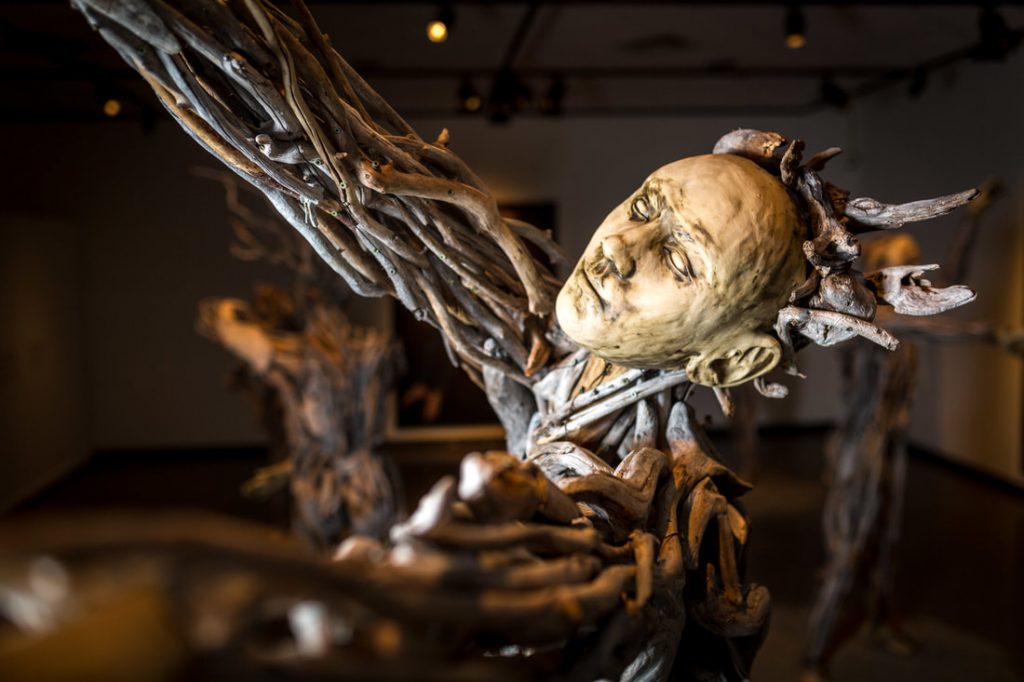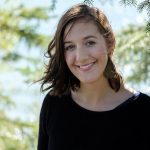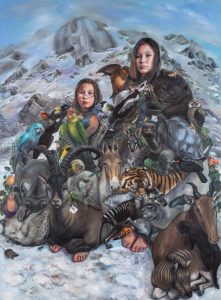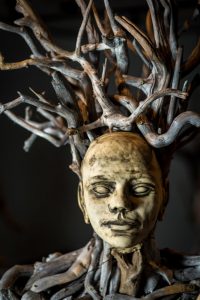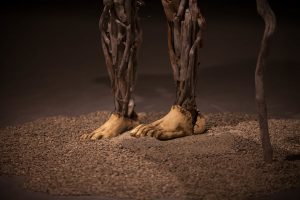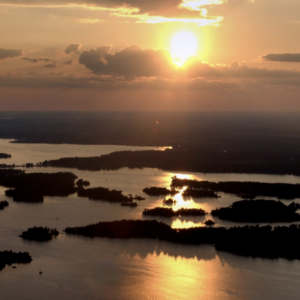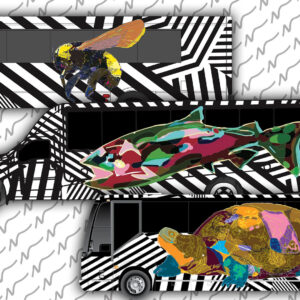An Artist’s Profile: Suzanne Paleczny
I was looking forward to the opportunity to interview Suzanne Paleczny. Her focus on the human relationship with Nature is very relevant to me, as I find myself brought back to it time and time again in my work and life. I believe that the way we understand our relationships with the land dictate how we react to our environment, how we make decisions, and how we shape our culture.
This blog post was a collaboration between our featured artist, Suzanne Paleczny and Chloe Dragon Smith, who interviewed Suzanne.
Part 1: Suzanne/Nature
First, I wanted to understand a bit about Suzanne’s personal relationship with Nature. Learning about Suzanne in this context would help me to understand much more about who she is, her worldview, and her art.
How did your childhood influence your connection to Nature?
In my first childhood home we lived on the edge of town with only two houses neighbouring our own. We were up on a hill and could see Lake Timiskaming from our yard although it was quite distant, and train tracks, roads and houses separated us from the lake. An enormous Manitoba Maple tree grew at the front of the house, its branches rising up beyond the height of our two storey house and then curving back down until they almost touched the grass, enveloping the entire front yard in this huge leafy umbrella. We played outside all the time, both under this tree and in the adjacent fields, bush and ravine.
My father, in particular, influenced my love of the outdoors. One of my earliest memories is of him taking my sisters and me for walks in the bush. We would start out walking along the train tracks and then would strike off into the forest. Eventually we would stop and make a fire and he would make us hot chocolate from his army rations. If it was spring he would make us whistles from the green willow branches. It was magical. As we got older we hiked and camped, paddled, rock climbed, skated and cross-country skied as a family. We returned again and again to the forests of my dad’s childhood in Northern Ontario.
What are your favourite things to do outdoors today?
I still love to camp and canoe, hike, skate and cross-country ski. The Yukon provides wonderful opportunities for all of these activities. For me, there is nothing better than sleeping outdoors. And although I don’t particularly like to cook, I love cooking outside over a fire!
When I was creating the sculptures for my recent body of work, Human/Nature, I spent two summers working outside in my carport. The sculptures are built from driftwood and range from 7 to 11 feet tall so required a working space that was beyond the size of my studio. We live about 30 km north of Whitehorse, in a quiet, rural setting and working outdoors was wonderful. The carport meant I was protected from the rain and direct sun, but I could still feel the wind and hear the birds, and in our seemingly endless summer days, enjoy the view of the mountains as the sun worked its way almost full circle around me. While I worked away I was visited by foxes, squirrels and birds, and on one occasion a mother bear and her two cubs even wandered through, deftly winding through the maze of sculptures without knocking any of them over. Luckily, I had just stepped inside to get something and so was not in their way! The first summer, I worked well into October, which was far too cold to be outside with bare hands and power drills, but I was not anxious to return to the confines of indoor work space.
Have those things changed throughout your life?
When our children were born we initiated them early into our favourite activities; our son was only 5 weeks old when we took him on his first overnight canoe trip in Bon Echo Park, and our eldest daughter, the ripe age of two weeks, for her first camping trip to Presqu’ile Park as we participated in the Bailey Bird Count. When our family grew too large for all of us to fit into one canoe, but the children were still too young to paddle, we did more camping in Provincial and National Park campgrounds. Once the kids were big enough to paddle and carry their own packs, we went back to doing more extended canoe trips and back-country hiking (which we continue to do now that we are again on our own).
How do you see them changing as you continue to age?
We continue to hike, paddle and ski and hope to spend many more years exploring the Yukon mountains and rivers. I suppose that we may become less willing or able to ‘rough it’ as we age. I have seen my own father change from someone who never passed up an opportunity to strike off into the bush with just a pack and an ax, to someone who now enjoys nature strictly through the window from the comfort of his arm chair.
Part 2: Art and life
Suzanne inspired me with her honesty, and stories of a life lived close with the land from her perspective. I was curious about how this lifestyle dedicated to connection with environment contributed to her path as an artist.
How much of your work throughout your life has been influenced by Nature?
Because nature has always been a large and important part of my life, it has influenced my art in various ways. Learning to observe nature influenced the way I observe everything around me. I am always on the lookout for effects created by sunlight and shadow and am inspired by colours and patterns that I see in nature. I am not, however, a landscape painter; the human figure is almost always incorporated into my artwork. Human/Nature is my first large body of work that is not just influenced by, but is specifically about nature.
Where did you get the ideas for your most recent exhibit – Human/Nature?
In many ways, my exhibit Human/Nature is a culmination of concerns and ideas that have come together throughout my life. The exhibit is loosely based on a thesis that I wrote in 2011, but even as a very young child, I remember being aware of and worried about pollution and the health of the planet. The exhibit was also created from a combination of both intellectual and visual ideas.
The intellectual ideas were influenced to a great extent by an undergrad degree in Cultural Studies and Philosophy that I completed in 2011 at Trent University. In my final thesis I examined our relationship with wilderness and our understanding of it, as indicated through its depiction in art and culture over thousands of years. In preparing to create Human/Nature I also read about ancient thought and philosophy, creation myths throughout the world, patterns in nature, interaction of trees in forest communities, recently extinct species, evolution, the beginning of the universe, etc.
Collecting visual ideas is a continuous and on-going process. Ideas can come from something as simple as a combination of colours that I see, a particular gesture that I observe, or other situations I encounter that can be used as visual metaphors. People, places and situations, in both Yukon and Egypt, came together to provide the visual inspiration for the paintings in Human/Nature.
The driftwood sculptures, on the other hand, were inspired by a visit to a specific place in Yukon called Sucker Bay. The bay lies at the juncture of two very long and narrow lakes. Any debris that falls into the waters gets channeled down by the prevailing wind and collects in the bay. As a result, the bay is chock full of driftwood; an endless supply of free art material! The first time I was introduced to the bay by some of my fellow art colleagues, I was struck by how much the individual pieces of driftwood resembled parts of our human anatomy—bones, muscles, tendons—and I could see its potential for what would eventually become the Human Forest installation. Rather than force a pre-determined pose for each of the tree figures, I let the shape of the driftwood determine what the gesture would be.
Check out more of Suzanne’s work here.
Part 3: We are Nature
I was compelled by Suzanne’s choice to mindfully follow the driftwood pieces as they dictated shape and posture of her human-tree figures. This is a small example of how we could all be living our lives by the contours of Nature: physical contours like rivers and mountains, as well as the rhythm of the seasons, right down to life lessons about relationships and tiny decisions we make every day. By losing our connection, have we lost our intuition about how to take care of the earth and also live good lives for ourselves? This concept is something that Suzanne has spent significant time thinking about.
I believe very much in the statement ‘we are Nature’ – Nature is not something separate from us. I know this is something you strive to explore and depict in your work. What does ‘we are Nature’ mean to you?
We are nature. This is not a metaphor, it is a fact. The phrase ‘we are Nature’ is a statement of awareness. With the exhibit Human/Nature, I was trying to make sense of why we treat the world so badly. I was trying to make sense of this disconnect between our awareness of the environmental crisis that is upon us and at the same time, the fact that we are not reacting with the urgency that this crisis deserves. And the only thing that I could think of, was that we must have somehow forgotten that we too are nature; that we are so used to living in a human-made world, that we have forgotten that nature is not something outside of us—someplace we go hiking in on the weekend—but that it is us. And this led me to the notion of memory.
Our own human story begins along with everything else in the world; as a bunch of chemical elements created through the life-cycle of the stars, and then as one-celled animals in ancient oceans and then as more and more complex animals until we eventually climbed out of the ocean. There are remnants of our ancient selves preserved in different structures of our bodies. For example, the fact that we get the hiccups is attributed to our earlier gill breathing days. If we have physical remnants of our ancient selves still present in us, then is it not conceivable that remnants of our ancient past might also be lodged in our memory? And so I began to imagine what it would be like if we could actually remember our origins. What if we could remember what it feels like to be stardust, or to live in salty seas, or to feel that connection that we have with everything else? Through the exhibit I am asking “what would having that sort of insight mean for us and for our world?” With this awareness, would we behave differently?
What do you think are the best ways to live that philosophy, as an individual, and as a society?
I have realized over the years that my artwork is often a question, but is seldom an answer. I don’t know the answer to the questions that I am posing; I just know that we need to figure it out together. I guess an important step is to recognize our own connection to the rest of the world and to understand that ours is a shared destiny. We need to make individual and societal decisions that reflect that knowledge; decisions that are based not on short term gain but on a long-term view that takes into consideration the collective good of future generations and the planet.
I know your exhibit was titled ‘Human/Nature’… This is very interesting to me, as I’ve had a lot of trouble with reconciling the concept of Nature in the past year or so. In many ways I see our language as a symptom of the way we relate to the world around us as ‘other’. I’d love to get your thoughts on that.
I think that your point is exactly right. That notion of the outer world as ‘other’ is embedded not just in language but in every aspect of modern Western culture, and it is inevitable that it should affect the way we act. The way we think about ourselves has been influenced over time by attitudes and philosophies that we may not even recognize as cultural ideas, and may mistake as truths. How will we set that right?
How will we set that right?
The weight of that question commands space to hang here; powerful yet without judgement, at the end of my conversation with Suzanne. How will we set that right? What do you think?

